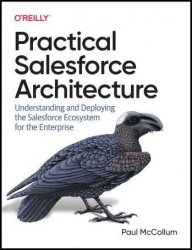Practical Salesforce Architecture: Understanding and Deploying the Salesforce Ecosystem for the Enterprise (Final)
- Добавил: literator
- Дата: 12-10-2023, 19:49
- Комментариев: 0
 Название: Practical Salesforce Architecture: Understanding and Deploying the Salesforce Ecosystem for the Enterprise (Final)
Название: Practical Salesforce Architecture: Understanding and Deploying the Salesforce Ecosystem for the Enterprise (Final)Автор: Paul McCollum
Издательство: O’Reilly Media, Inc.
Год: 2024
Страниц: 183
Язык: английский
Формат: True EPUB (Retail Copy)
Размер: 10.2 MB
Once renowned as a customer relationship management tool, Salesforce has evolved into a cloud-first application and capability ecosystem. With dedicated components for tasks such as middleware, Big Data, reporting, ETL, data loading, and API orchestration, Salesforce has become more prevalent in modern architectures.
This concise yet comprehensive guide provides an overview of Salesforce architecture for enterprise architects and Salesforce ecosystem architects. Author Paul McCollum, Salesforce Technical Architect at Accenture, provides a roadmap for integrating major elements of the Salesforce ecosystem with planned or existing enterprise architecture. You'll learn how to use these components to address the diverse needs of different organizations.
Many companies today are adding or building multicloud capabilities and incorporating various elements from the Salesforce ecosystem.
With this book, you'll learn:
• Strengths, weaknesses, and growth areas of Salesforce's enterprise architecture domain features
• How Salesforce compares to other cloud providers
• Methods for using the Salesforce ecosystem effectively to address your organization's needs
• How to integrate Salesforce with planned or existing enterprise architectures
• Ways to manage and forecast performance, complexity, and ease of operation across the Salesforce platform
Who This Book Is For:
This book is intended to be a sort of Rosetta Stone for enterprise architects looking to gain knowledge of how the Salesforce ecosystem works at a macro level. The aim is to explain what the components of the very broad Salesforce offerings do. It will accomplish this by utilizing the classic and widely recognized enterprise systems and capability frameworks as reference points.
Salesforce encompasses a large number of components, many of which have been renamed and/or rebranded over time. It can be very difficult to translate the novel terms from within the ecosystem to their popular capabilities. This book will introduce you to the vocabulary used in Salesforce and help you understand what role it can play in your organization, work, or learning journey.
The first and most critical point to understand is that the name “Salesforce” is a huge misnomer today. Salesforce started as a customer relationship management (CRM) tool. Then it grew. It now has a range of components and level of complexity that put it on par with Microsoft (and Azure), Amazon (and Amazon Web Services), Google (and Google Cloud Platform), and Oracle (and Oracle Cloud). Underestimating its scale and breadth will stall your comprehension. All the names and brands make it hard to figure out what’s what. This book is your lifeline.
Senior Salesforce architects can use this book as an introduction to enterprise architecture terms and concepts, to help you grow into a multicloud enterprise architect. Some of the features, products, and capabilities evolving within the Salesforce ecosystem are composed of concepts that exist in the non-Salesforce realm, but that have evolved independently or been designed to act differently during their lifespan within Salesforce. Imagine having grown up with scissors, but never having seen a knife. In this book we’ll be talking about taking apart tools like those scissors and talking about the pieces and how and why they come together—and maybe why they shouldn’t.
Скачать Practical Salesforce Architecture: Understanding and Deploying the Salesforce Ecosystem for the Enterprise (Final)
[related-news] [/related-news]
Внимание
Уважаемый посетитель, Вы зашли на сайт как незарегистрированный пользователь.
Мы рекомендуем Вам зарегистрироваться либо войти на сайт под своим именем.
Уважаемый посетитель, Вы зашли на сайт как незарегистрированный пользователь.
Мы рекомендуем Вам зарегистрироваться либо войти на сайт под своим именем.
